Join the Hide community
Get access to live stream, lessons, the post exchange, and chat with other snipers.
Register
Download Gravity Ballistics
Get help to accurately calculate and scope your sniper rifle using real shooting data.

Install the app
How to install the app on iOS
Follow along with the video below to see how to install our site as a web app on your home screen.
Note: This feature may not be available in some browsers.
You are using an out of date browser. It may not display this or other websites correctly.
You should upgrade or use an alternative browser.
You should upgrade or use an alternative browser.
Hand loading for Long range 1: brass case prep
- Thread starter TresMon
- Start date
In most bolt rifles, .002"-.003" is all you want for shoulder bump to get reliable bolt cycling etc without working the brass too much.
I've had help from a couple people since I started reloading. Your help is greatly appreciated Tres!! Thank you!
im confused, so how did you come up with the number.003 to "bump" the shoulder back?
While the above question was from years ago, I didn't see where anyone had answered it. So, here goes. There are tools made that are attached to micrometer calipers that will measure from the base of the cartridge case to a datum line about mid way up the case's shoulder. Measure the cases before sizing, then adjust your die so that the shoulder is only pushed back by 2-3 thousandths. I watch the ring of case lube as the lube gets squeegeed down the case neck by the sizing die to tell me how close the part of the die that contacts the case's shoulder is to the case.
Just now getting into PR loading I just found this thread and still reading page one. I'm looking forward to reading the rest. I have ordered 100 Lapua cases but will practice my first rounds using Hornady once fired(from my rifle) cases once I all my goodies come in, Forster dies, etc.
I read page 1 years ago and utilized many of the techniques over the last ten years to improve my knowledge and reloading practices.
I think it’s important to note that our
understanding of best practices have improved over the years and some things in the initial post are no longer considered “best practice”.
Please note, this is in no way a dig on the OP. He was instructing on the methods that were used at the time but in ten years we really have come a long way in the number of shooters, gear and our understanding of these things. Most guys aren’t shooting a Remington 700 in 308 any more, our gear has advanced and so has our understanding of reloading. I am by no means the end-all be-all of reloading but want new guys to know that there are some things more important than others since there is a lot of incorrect or partially true information out there. Hope this helps.
1-primer pocket uniforming. Pretty low on the priority list for accuracy or reliable ignition. Many F-Class and benchrest guys don’t even do it now from what I understand. It can hurt more than help in many cases. For field and PRS type stuff, I wouldn’t bother. Maybe de-burr the inside of the flash hole the first time only. I don’t bother.
Same goes for weight sorting, checking case capacity with water and sorting by volume, etc. Erik Cortina of Team Lapua and F-Class world championship fame has dispelled a lot of these myths for the “common man” through testing what works and what doesn’t for himself. He doesn’t sort brass anymore, which is good enough for me.
2-Neck sizing. I think most pro’s, if not all, are done preaching the “neck sizing only” or “3 out of 4 times” thing. It was a fad for a long time that many average people still parrot but it usually results in you getting burned at a match or on a hunt with hard to chamber rounds and stuck fired cases and in extreme cases galled lugs.
In addition to those very serious reliability issues it actually isn’t necessary at all to help accuracy. If you are only bumping the shoulder .001-.003” in a bolt gun or .003”-.005” in a semi-auto you are in the sweet spot. You need a Hornady shoulder-bump comparator or similar tool to measure this ($30, well worth the money). No you aren’t harming accuracy, overworking brass or causing case head separation by full length sizing the body and bumping the shoulder the above amounts. What you are doing is helping ensure you can chamber your cartridge even when your gun is hot, dirty, wet, etc. There’s literally no downside that I know of to full length sizing with minimal bump vs neck sizing only.
Most precision shooters are annealing these days and most are full length sizing with this method. Primer pockets usually go before anything else, even with mild loads when you’re doing it right.
3-Neck tension. It matters. It contributes to your SD/ES which is what determines the amount of vertical stringing you get at distance (or lack there-of). The less of that the better so many handloaders have become obsessed with low Extreme Spread and Standard Deviation and for good reason. Best way to get consistent neck tension? I’ll let others explain that one, lol.
There are multiple ways to skin that cat. I personally am lazy and want to spend the least amount of time possible prepping brass to get half moa accuracy or better and SD’s under 10-15.
I will not build a tight-neck chambered rifle that requires neck turning. It’s not necessary to accuracy and adds more work. I have used Redding type S full length bushing dies with good success but hate having to buy different bushings at $30 per. I’m contemplating messing with the precision mandrels to set neck tension but will have to tweak my personal process a bit around that.
The simple answer that quickly gets more complicated is to measure the outside diameter of a LOADED piece of brass with the particular bullet you plan to shoot and subtract .002-.003” and that’s the size bushing you buy to set proper neck tension. So for example I shoot Berger 6mm 109 gr hybrids in my favorite match gun. The OD of the neck with a 109 loaded in the Hornady brass I shoot is .265”. So I would buy the .262” or .263” bushing and use that.
(important note) If you leave the sizing button in the die then the neck tension you think you’re getting may not be happening because as you pull the brass over that sizing button on the down-stroke it can open the case mouth up and change the neck tension you just set with the bushing. That’s why many people remove the sizing button from off the decapping rod on their bushing dies.
What if one of your precious cases gets stepped on or dented when the case mouth hits concrete or a rock? Do you just set the neck tension with a bushing and use the bullet to round out the case mouth? That to me would cause inconsistent neck tension.
So then you get into the mandrels to uniform the inside of the case mouth. Whether you use a standard expander mandrel before sizing and then set tension with a bushing die or you use a precision honed mandrel after the sizing die is up to you. There are also honed dies from companies like Whidden and Forester that people use to accomplish similar things. The method is different but most agree that neck tension matters. How you get there may take some experimentation on your part.
I hope this helps newer or intermediate reloaders focus their time and money on good tools and current best practices that have been learned by thousands of shooters sending millions of hand-loaded precision freedom seeds down range in the last 10-20 years.
I think it’s important to note that our
understanding of best practices have improved over the years and some things in the initial post are no longer considered “best practice”.
Please note, this is in no way a dig on the OP. He was instructing on the methods that were used at the time but in ten years we really have come a long way in the number of shooters, gear and our understanding of these things. Most guys aren’t shooting a Remington 700 in 308 any more, our gear has advanced and so has our understanding of reloading. I am by no means the end-all be-all of reloading but want new guys to know that there are some things more important than others since there is a lot of incorrect or partially true information out there. Hope this helps.
1-primer pocket uniforming. Pretty low on the priority list for accuracy or reliable ignition. Many F-Class and benchrest guys don’t even do it now from what I understand. It can hurt more than help in many cases. For field and PRS type stuff, I wouldn’t bother. Maybe de-burr the inside of the flash hole the first time only. I don’t bother.
Same goes for weight sorting, checking case capacity with water and sorting by volume, etc. Erik Cortina of Team Lapua and F-Class world championship fame has dispelled a lot of these myths for the “common man” through testing what works and what doesn’t for himself. He doesn’t sort brass anymore, which is good enough for me.
2-Neck sizing. I think most pro’s, if not all, are done preaching the “neck sizing only” or “3 out of 4 times” thing. It was a fad for a long time that many average people still parrot but it usually results in you getting burned at a match or on a hunt with hard to chamber rounds and stuck fired cases and in extreme cases galled lugs.
In addition to those very serious reliability issues it actually isn’t necessary at all to help accuracy. If you are only bumping the shoulder .001-.003” in a bolt gun or .003”-.005” in a semi-auto you are in the sweet spot. You need a Hornady shoulder-bump comparator or similar tool to measure this ($30, well worth the money). No you aren’t harming accuracy, overworking brass or causing case head separation by full length sizing the body and bumping the shoulder the above amounts. What you are doing is helping ensure you can chamber your cartridge even when your gun is hot, dirty, wet, etc. There’s literally no downside that I know of to full length sizing with minimal bump vs neck sizing only.
Most precision shooters are annealing these days and most are full length sizing with this method. Primer pockets usually go before anything else, even with mild loads when you’re doing it right.
3-Neck tension. It matters. It contributes to your SD/ES which is what determines the amount of vertical stringing you get at distance (or lack there-of). The less of that the better so many handloaders have become obsessed with low Extreme Spread and Standard Deviation and for good reason. Best way to get consistent neck tension? I’ll let others explain that one, lol.
There are multiple ways to skin that cat. I personally am lazy and want to spend the least amount of time possible prepping brass to get half moa accuracy or better and SD’s under 10-15.
I will not build a tight-neck chambered rifle that requires neck turning. It’s not necessary to accuracy and adds more work. I have used Redding type S full length bushing dies with good success but hate having to buy different bushings at $30 per. I’m contemplating messing with the precision mandrels to set neck tension but will have to tweak my personal process a bit around that.
The simple answer that quickly gets more complicated is to measure the outside diameter of a LOADED piece of brass with the particular bullet you plan to shoot and subtract .002-.003” and that’s the size bushing you buy to set proper neck tension. So for example I shoot Berger 6mm 109 gr hybrids in my favorite match gun. The OD of the neck with a 109 loaded in the Hornady brass I shoot is .265”. So I would buy the .262” or .263” bushing and use that.
(important note) If you leave the sizing button in the die then the neck tension you think you’re getting may not be happening because as you pull the brass over that sizing button on the down-stroke it can open the case mouth up and change the neck tension you just set with the bushing. That’s why many people remove the sizing button from off the decapping rod on their bushing dies.
What if one of your precious cases gets stepped on or dented when the case mouth hits concrete or a rock? Do you just set the neck tension with a bushing and use the bullet to round out the case mouth? That to me would cause inconsistent neck tension.
So then you get into the mandrels to uniform the inside of the case mouth. Whether you use a standard expander mandrel before sizing and then set tension with a bushing die or you use a precision honed mandrel after the sizing die is up to you. There are also honed dies from companies like Whidden and Forester that people use to accomplish similar things. The method is different but most agree that neck tension matters. How you get there may take some experimentation on your part.
I hope this helps newer or intermediate reloaders focus their time and money on good tools and current best practices that have been learned by thousands of shooters sending millions of hand-loaded precision freedom seeds down range in the last 10-20 years.
Last edited:
Hi, so I am trying your method of “bumping the shoulder back” .003Let's look at our cartridge brass first. Everything we do in hand loading is in the name of consistency, shot to shot. (Technically not "reloading" which is quick & expedient for the likes of short range speed shooting such as IPSC & Steel challenge shoots.)
So there it is before us- a fine specimen of a fired case. We need to resize our cases as well as deprime them. But before we do that, our case has a vital piece of information it's dying to give us.
When we resize the case we want it to stay a precision fit to the individual rifle's chamber from which it was fired. If we go ahead and resize it we have lost this information of the rifle's length of headspace.
We need a tool for this.
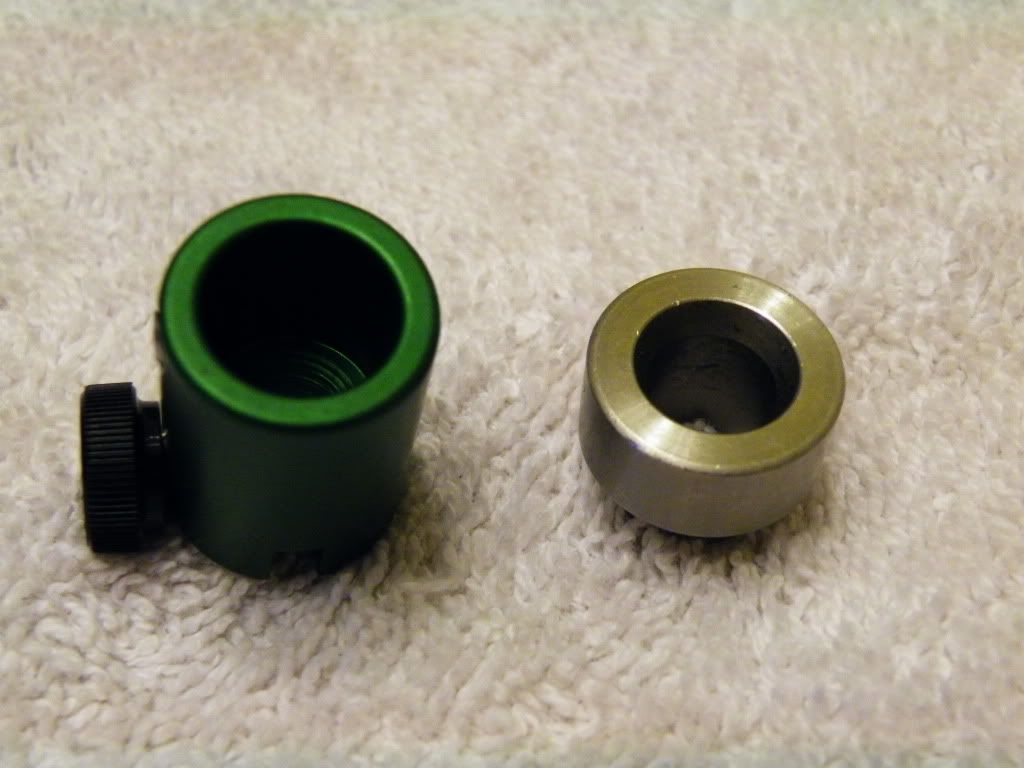
But we are going to measure the case from it's head (where the writing is) to the datum of the shoulder. For this we need the above illustrated tool:
http://www.sinclairintl.com/product/5574/Case-Gauges-Headspace-Tools
this holds the insert onto your calipers. You'll also need the insert specific to your cartridge: http://www.sinclairintl.com/product/11264/Case-Gauges-Headspace-Tools
Her's a photo of measuring the freshly fired case form the rifle to obtain a headspace measurement:
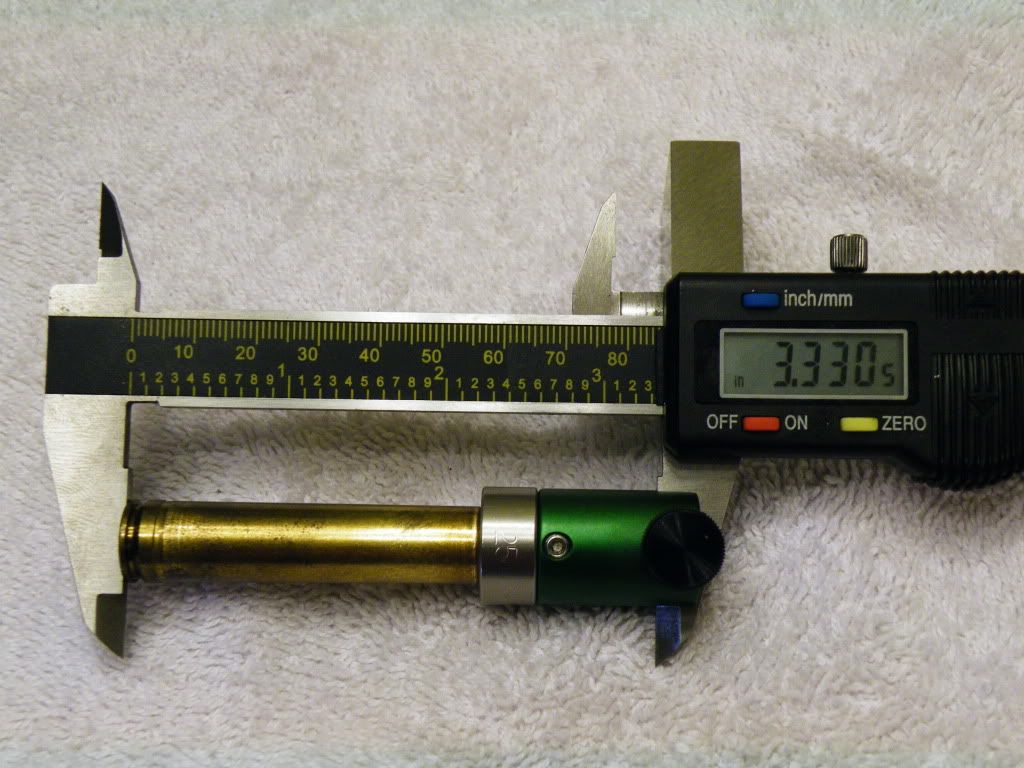
So now we know this length of the fired case, we set up the resizing die in the press to "bump" the shoulder back to three thousandth's of an inch (.003") under/shorter than this length. This gives clearance for loading and unloading the unfired round, but maintains a snug fit in the chmaber so the round and bullet is held on centerline with the bore for ultimate accuracy. It also keeps us from over working brass. If we size it way back, and it stretches way out on firing, and continue this the brass case will seperate from the head!
Here we can see from the original measurement that we have moved or "bumped" the shoulder back .003":
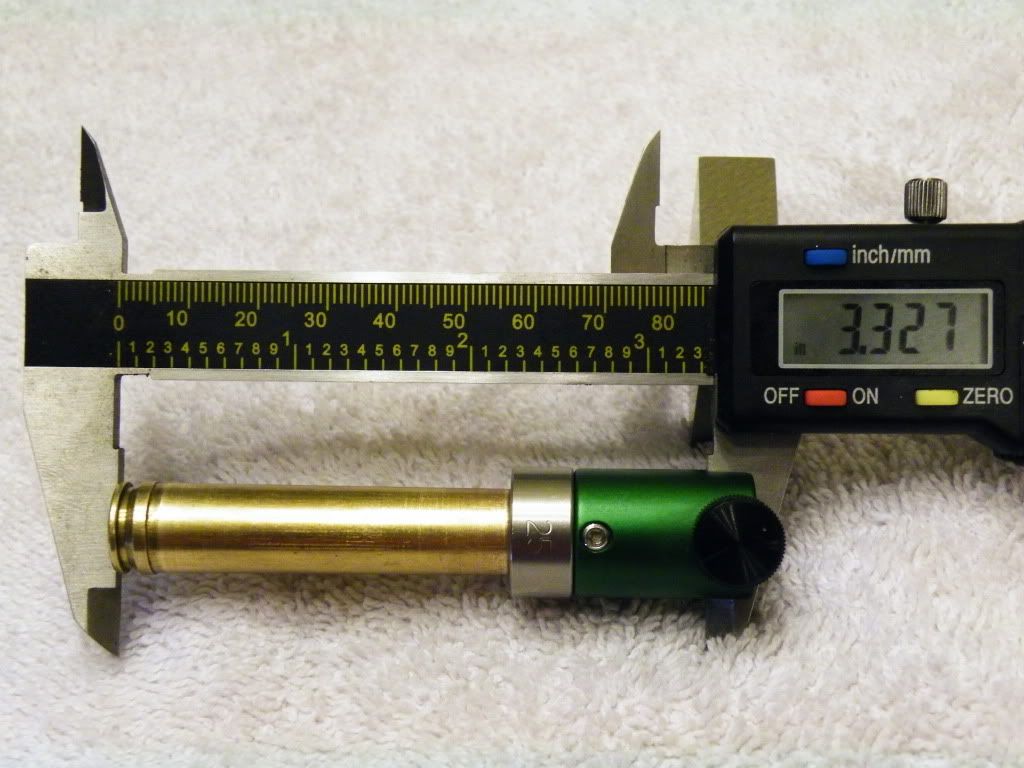
Until you get the tool in the mail: take a fired case and wipe it off with a rag & alcohol etc. Use a candle or lighter and burn black soot onto the shoulder of the case.

Back out your resizing die a few turns on the press. Press the case up into the resizing die and withdraw it. Did you get lines on the shoulder of the case? No? screw in the die a little more and repeat. Continue this process until you get faint lines in the soot.
In this photo you can see the line in the soot where the neck bushing stopped on the neck, as well as a line and some dappled marks where the shoulder was just touched by the Resizing die:
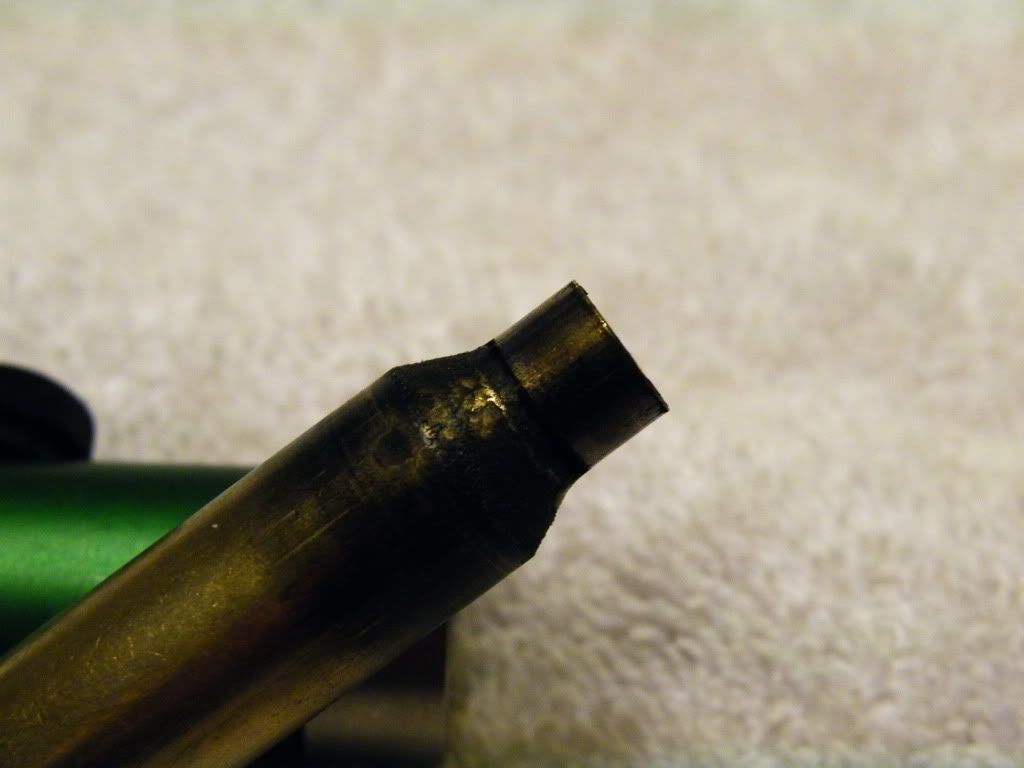
Now wipe off the case and chamber the empty case in the rifle and see how the bolt feels as it closes. Was their any resistance? You want to bump the shoulder of the case back just enough that your borderline of having/not having a teeny bit of resistance in closing the bolt on the case. Now you have your resizer die set as well as you can until the proper tool arrives in the mail. Now resize all your cases.
Annealing:
If your brass has been fired a few times, it has & is hardening.
Brass work hardens. Shoot it, Resize it, Tumble it it all hardens it. Which means some will be harder/stronger on it's grip of the bullet than others and our consistency in everything we are trying to achieve went right out of the window; this example in known as "Neck tension" or the amount of grip of the case neck on the bullet.
Annealing: anneal your brass cases every 3 firings at least. I anneal mine every 2. You only anneal the neck and shoulder, not the HEAD! There are fancy case annealing machines, but I don't have that kind of money. Here's what I do:
Get you some 650 degree rated Tempilaq. Tempilaq basically looks like an over sized bottle of fingernail polish.

It comes in heat grades. We used it in Machine shops for various tasks. You basically paint a stripe on your metal and let it dry. Apply heat and when it gets to the temperature you wanted the Tempilaq liquefies and the color (yellow) disapeers.
I paint a stripe INSIDE the mouth of my cases.

After it dries I hold the head of the case in my bare fingers and turn the mouth of the case in the flame of a propane torch. When my yellow paint of the 650 deg. Tempilaq disapeers I drop the case in a bucket of water. When all the cases are done, I now have soft case mouths that are uniform. (in neck tension on the bullet after loaded.)

A word of Caution: you never want the Head of the case (the part that has writing on it) to get so hot you can't hold it. If you soften the head of the case you have created a very dangerous as well as troublesome situation. Like at the least shoot the case, even a light load and the primer falls out. And on from there with far greater personal risk/danger.
Cleaning:
And while we are babying our brass, I do what many benchrest shooters have switched too: I use an ultrasonic cleaner to clean my brass. Vibratory tumblers only "pretty-fy" brass. It does not clean the inside, the flash hole nor the primer pocket. I do not need or care if the outside of my brass is shiny. As a long range shooter, I need the inside, the flash hole and the primer pocket to be clean in the name of uniform combustion & burn, shot to shot. Also all the rattling together of cases in the vibrator peens the cases together work harding them all the more though minimal.
Get you a Ultrasonic cleaner (on the cheap from Harbor Freight.) Throw in your resized/deprimed cases. Cover the cases with distilled water. Then add 1 tablespoon of dish detergent as well as 3-6 tbsp of your favorite liquid brass cleaner. Birchwood-Casey, Lyman Turbo, etc. Any of the liquid products intended to be added into vibratory tumbling media.
Run the U.Sonic Cleaner 20 minutes to an hour depending on the size & amount of cases until they are totally clean on the inside and the primer pockets are all at least 95% clean. Rinse in a 5
gallon (etc.) bucket of distilled water and shake off. After they air dry or you hair dry(er) them your good to go. Tap water contains substances that can cause cartridge brass to oxidize. Stay with distilled.
[edit: after you clean your brass with your preferred manner, if you used Tempilaq to anneal them, you may need to use a bore brush to clean the burned tempilaq out of the case mouths. Make sure your case mouths are clean always in the name of consistent neck tension.]
Sorting:
So we'll continue by sorting all your brass by brand. Then I sort it by weight. Every body talks about Lapua brass being the best, but Winchester brass is at least 96% as good and cheaper.
Sort all your best brass cases <span style="font-style: italic">at least</span> into 2 grain lots. (All of this batch of cases weigh within 2 grains of each other.)
One grain lots is really splitting hairs. It's up to you if you think the accuracy gains is worth your time & depending your rifle's capabilities. In everything on this subject of hand loading I like to error on the side of overkill.
This let's you know each case has about the same brass content, which tell's us their of the same average dimensions, which means we have the same sized combustion chambers case to case, to give us consistent MV shot to shot.
Uniform all the primer pockets. Here's a dirty, uneven once fired primer pocket:
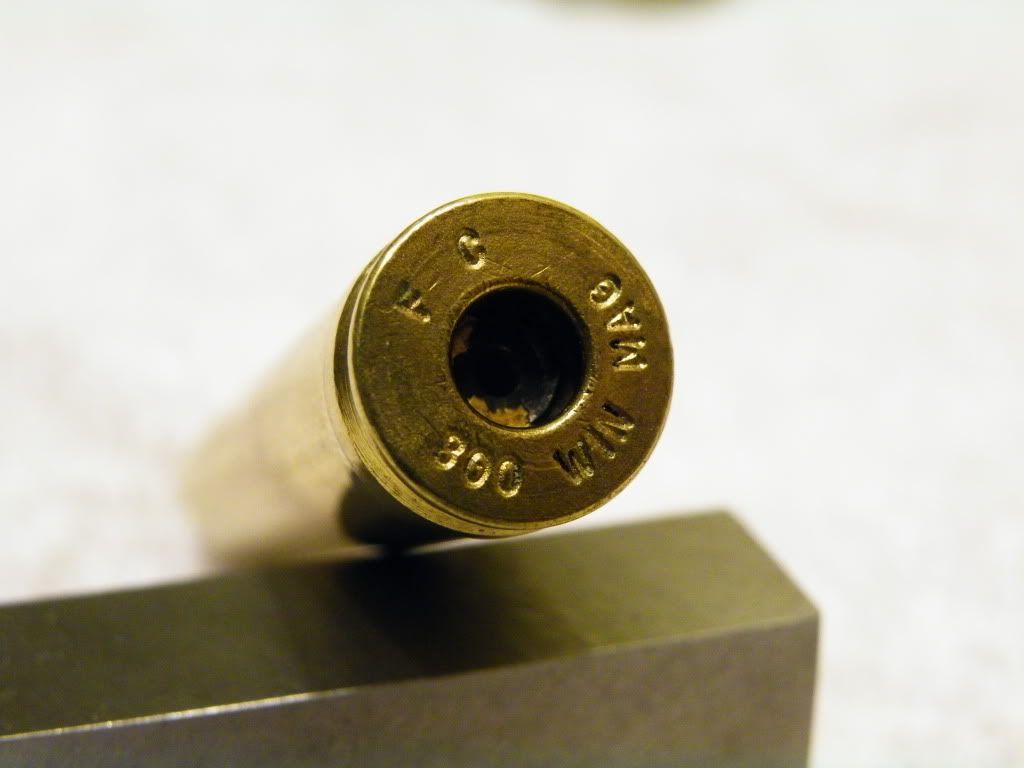
Primer pocket uniforming cuts all the primer pockets to exactly the same depth, in the name of consistent and uniform ignition. Here's the tools, a cleaned and uniformed pocket and the bulk of the material that was removed:
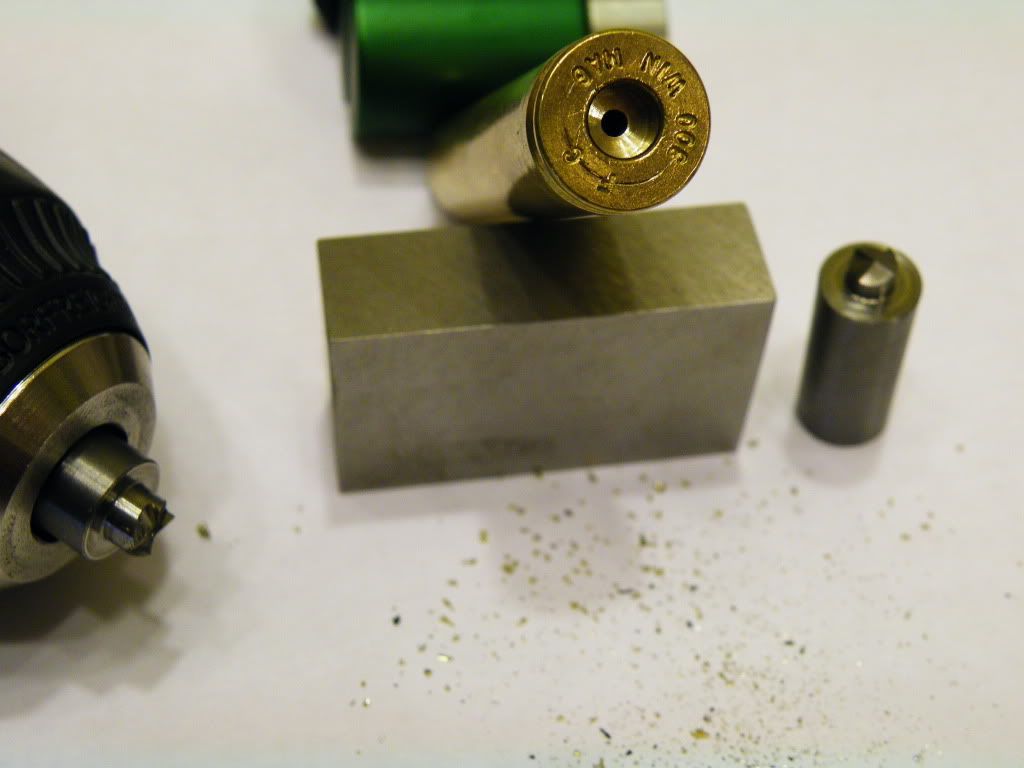
Deburr the flash holes.
The flash hole is the hole in the head of the case that the sparks pass through to ignite the powder. In the manufacturing process this hole is not drilled, it is punched and that generally leaves a burr on the inside, or the whole "flap" of metal that was punched out. This can shield a portion of the powder from the sparks and lead to inconsistent ignition, case to case. A deburring tool does just that- cleans up the powder side of the flash hole for consistent ignition. This particular type tool has the depth preset so the cutter (a common center-drill) can only cut so deep into the flash hole:
![url]](http://[url=%22http://i664.photobucket.com/albums/vv6/TresMonCeret/snipershidech1011WinCE.jpg%22]http://i664.photobucket.com/albums/vv6/TresMonCeret/snipershidech1011WinCE.jpg[/url])
![url]](http://[url=%22http://i664.photobucket.com/albums/vv6/TresMonCeret/snipershidech1012.jpg%22]http://i664.photobucket.com/albums/vv6/TresMonCeret/snipershidech1012.jpg[/url])
All the mail order companies and most local shops carry these simple tools. A primer pocket uniformer can be used after each firing to clean the carbon out of the pocket. But you should at least revisit the primer pockets of your cases every three firings as the brass flows with each shot and they will eventually no longer be uniformed.
Trim to length: upon firing of the loaded round the case greatly softens and inflates like a balloon to fill the chamber of the weapon. This seals the chamber and prevents gas leaks, etc. but with the brass nearing a liquid ("plastic") state it flows with the pressure of the propellant gas. Hence as stated before our primer pockets not staying uniform, the over all length of the case grows and the mouth of the case typically thins. Your reloading manual will give you the nominal "trim to length" measurement of a given cartridge case. So place said case in your case trimmer and trim it back correct? No.
NO!!! We are precision shooters for crying out loud. I have a friend that mows every case he get's his hands on back to minimum length and it gripes me to no end.
Historically & generally speaking the classic ultra accurate cartridges of the Bench Rest enviornment have longer than normal case necks. The typical case neck for a given cartridge is one caliber wide. Example: a 308 Winchester's bullet is a diameter of .308" so therefore the rule of thumb is the mouth of the case should be "about" .308" long minimum. This allows good bullet tension and support so our carefully assembled loaded round's bullet is sitting dead inline with the cases' centerline- which is inline with the centerline of the bore. All this leads to good shooting and smiles. The more we hack back the case mouth the less neck we have to make sure our bullet is held inline. And the benchrest cartridges I mentioned- they have caliber plus neck lengths for this reason.
So what do we do? If the case gets to long, it will engage the rifling at the same time the bullet tries to giving us a wild & very dangerous pressure spike. If we hack it back to bare minimum we may have given room for a little loss of accuracy, especially with rough handling of ammo in the field. But we HAVE TO maintain consistency from case to case for shot to shot.
The answer is to measure the chamber length in your individual rifle and stay trimmed back from that actual number. Small chamber plugs to get that measurement are sold by Sinclair and others.
http://www.sinclairintl.com/product/11241/Case-Gauges-Headspace-Tools
Here is one I whipped out on the lathe yesterday for 30 cal:
![url]](http://[url=%22http://i664.photobucket.com/albums/vv6/TresMonCeret/snipershidech1014.jpg%22]http://i664.photobucket.com/albums/vv6/TresMonCeret/snipershidech1014.jpg[/url])
To use a gage like this:
1. thoroughly clean your weapons chamber.
2. take a scrap case and trim it WAY back with your case trimmer, say .050" SHORTER than book spec.
3. Seat you plug gage into the case- long.
4.ease this round into your weapon and fully close & lock the bolt.
5. remove the case gently without bumping the gage. It has hit the end of the chamber and been pushed back into the case by the action of locking the bolt.
Measure the overall length of the case, head of the case to end of the plug and note that measurement somewhere obvious & permanent in regards to loading for this particular rifle. It would probably be a good idea to repeat this measurement three times and average all three readings.
Now until this dimension were to change (barrel removal, etc.) trim your brass just short of this measurment, instead off BOOK trim to length specs.
Once we have our cases all trimmed to a uniform length to our specific rifle we now need to deburr the mouth.
I'm sure anybody that is reloading knows what a deburring tool looks like for handloading, others just do a google search. Deburr the outside of the case just enough to remove the burr and put the slightest bevel on the edge of the case- the most minimal possible. As far as deburring the inside, gently cut a bevel on the inside of the case untill it goes almost full diameter- that is the bevel cuts to the outside edge of the case mouth when looking from the end.
It is next to impossible to photograph but you can see this inside chamfer is cut almost, but not all the way to the outside edge of the case:
![url]](http://[url=%22http://i664.photobucket.com/albums/vv6/TresMonCeret/snipershidech1016.jpg%22]http://i664.photobucket.com/albums/vv6/TresMonCeret/snipershidech1016.jpg[/url])
This is so that when we seat our precious bullet, the opening of the case mouth of the case does not cut,mar or peel back small portions of the soft bullet jacket.
And last but not least we need to prime our case. Practically every company that handles reloading components sell priming tools. For the wealthier individuals I'd point you towards Sinclair International and those type suppliers. But a good job of priming can be done with lesser priced tools.
The main thing is the tool have as much "feel" of the process as possible. You want to be able to clearly feel the primer bottom out in the primer pocket of the case, so you can keep the primers seated consistently case to case to case. This pre-loads the anvil of the primer the same for each round giving more uniform ignition shot to shot.
-----------------------------------------------------------------------
This instructional took considerable time & effort. It is presented here for free. Enjoy! However if any one feels motivated to express appreciation a donation can be sent to the paypal account [email protected]. No big deal. Thanks! TresMon
I have RCBS FL die for my .308 and a hornady “Lock N Load headspace comparator kit”
When I measure my .308 brass (all the same brand) after once fired they measure 1.629 after I size them they come out longer 1.633” that is screwed all the way down. If I loosen the die the number will gradually go back to 1.629 gradually. How is my brass getting longer after sizing? And how is it still chambering just fine. It makes no sense to me.
Any help would be appreciated. Thank you.
Hi, so I am trying your method of “bumping the shoulder back” .003
I have RCBS FL die for my .308 and a hornady “Lock N Load headspace comparator kit”
When I measure my .308 brass (all the same brand) after once fired they measure 1.629 after I size them they come out longer 1.633” that is screwed all the way down. If I loosen the die the number will gradually go back to 1.629 gradually. How is my brass getting longer after sizing? And how is it still chambering just fine. It makes no sense to me.
Any help would be appreciated. Thank you.
It's common that a fired case will still chamber just fine, though after a number of firings without shoulder bumping, it will not.
From your description, it sounds like you've got an issue with the expander ball pulling up through the neck with a lot of resistance. If there's not enough lubrication, an expander ball can pull up with enough force of pull on the shoulder some with the result you describe. Though, I don't understand what you're describing when you say "if I loosen the die the number will gradually go back to 1.629 gradually". I feel if you lube the inside of you're necks enough, you shouldn't see that growth you're talking about.
So I just swapped a brand new die in. And my problem was solved. Somthing is off with that die. No idea what. But now I’m bumping them back to 1.627” so g2gIt's common that a fired case will still chamber just fine, though after a number of firings without shoulder bumping, it will not.
From your description, it sounds like you've got an issue with the expander ball pulling up through the neck with a lot of resistance. If there's not enough lubrication, an expander ball can pull up with enough force of pull on the shoulder some with the result you describe. Though, I don't understand what you're describing when you say "if I loosen the die the number will gradually go back to 1.629 gradually". I feel if you lube the inside of you're necks enough, you shouldn't see that growth you're talking about.
Thank you for the response. I appreciate it. I will be reading more of your other two posts. Trying to dial in my hand loads better. So I may have another question or two in the short term.
Similar threads
- Replies
- 15
- Views
- 592
